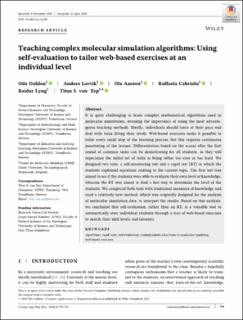| dc.contributor.author | Dahlen, Oda | |
| dc.contributor.author | Lervik, Anders | |
| dc.contributor.author | Aarøen, Ola | |
| dc.contributor.author | Cabriolu, Raffaela | |
| dc.contributor.author | Lyng, Reidar | |
| dc.contributor.author | van Erp, Titus Sebastiaan | |
| dc.date.accessioned | 2020-08-27T07:15:34Z | |
| dc.date.available | 2020-08-27T07:15:34Z | |
| dc.date.created | 2020-08-20T20:22:32Z | |
| dc.date.issued | 2020 | |
| dc.identifier.citation | Computer Applications in Engineering Education. 2020, 28 (4), 779-791. | en_US |
| dc.identifier.issn | 1061-3773 | |
| dc.identifier.uri | https://hdl.handle.net/11250/2675292 | |
| dc.description.abstract | It is quite challenging to learn complex mathematical algorithms used in molecular simulations, stressing the importance of using the most advantageous teaching methods. Ideally, individuals should learn at their pace and deal with tasks fitting their levels. Web‐based exercises make it possible to tailor every small step of the learning process, but this requires continuous monitoring of the learner. Differentiation based on the scores after the first round of common tasks can be demotivating for all students, as they will experience the initial set of tasks as being either too easy or too hard. We designed two tests, a self‐monitoring test and a rapid test (RT) in which the students explained equations relating to the current topic. The first test was aimed to see if the students were able to evaluate their own level of knowledge, whereas the RT was aimed to find a fast way to determine the level of the students. We compared both tests with traditional measures of knowledge and used a relatively new method, which was originally designed for the analysis of molecular simulation data, to interpret the results. Based on this analysis, we concluded that self‐evaluation, rather than an RT, is a valuable tool to automatically steer individual students through a tree of web‐based exercises to match their skill levels and interests. | en_US |
| dc.language.iso | eng | en_US |
| dc.publisher | Wiley Periodicals LLC | en_US |
| dc.title | Teaching complex molecular simulation algorithms: Using self‐evaluation to tailor web‐based exercises at an individual level | en_US |
| dc.type | Peer reviewed | en_US |
| dc.type | Journal article | en_US |
| dc.description.version | publishedVersion | en_US |
| dc.source.pagenumber | 779-791 | en_US |
| dc.source.volume | 28 | en_US |
| dc.source.journal | Computer Applications in Engineering Education | en_US |
| dc.source.issue | 4 | en_US |
| dc.identifier.doi | 10.1002/cae.22249 | |
| dc.identifier.cristin | 1824366 | |
| dc.relation.project | Norges forskningsråd: 237423 | en_US |
| dc.description.localcode | This is an open access article under the terms of the Creative Commons Attribution License, which permits use, distribution and reproduction in any medium, provided the original work is properly cited. | en_US |
| cristin.ispublished | true | |
| cristin.fulltext | preprint | |
| cristin.qualitycode | 1 | |
